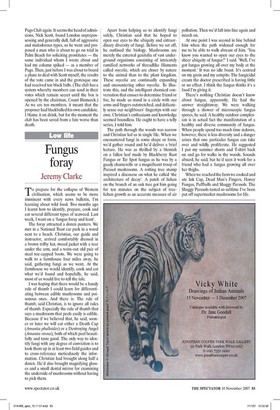Fungus foray
Jeremy Clarke o prepare for the collapse of Western civilisation, which seems to be more imminent with every news bulletin, I'm learning about wild food. Two months ago I learnt how to identify, prepare, cook and eat several different types of seaweed. Last week, I went on a 'fungus foray and feast'.
The foray attracted a dozen punters. We met in a National Trust car park in a wood next to a beach. Christian, our guide and instructor, arrived comfortably dressed in a brown trilby hat, tweed jacket with a tear under the arm, and a worn-out old pair of steel toe-capped boots. We were going to walk to a farmhouse four miles away, he said, gathering fungi as we went. At the farmhouse we would identify, cook and eat what we'd found and hopefully, he said, most of us would live to tell the tale.
I was hoping that there would be a handy rule of thumb I could learn for differentiating between edible mushrooms and poisonous ones. And there is. The rule of thumb, said Christian, is to ignore all rules of thumb. Especially the rule of thumb that says a mushroom that peels easily is edible. Because if we believed that, he said, sooner or later we will eat either a Death Cap (Amanita phalloides) or a Destroying Angel (Amanita virosa), both of which peel beautifully and taste good. The only way to identify fungi with any degree of conviction is to look them up in at least two field guides and to cross-reference meticulously the information. Christian had brought along half a dozen. He'd also brought magnifying glasses and a small dental mirror for examining the underside of mushrooms without having to pick them.
Apart from helping us to identify fungi safely, Christian said that he hoped to open our eyes to the ubiquity and extraordinary diversity of fungi. Before we set off, he outlined the biology. Mushrooms are merely the external genitalia of vast underground organisms consisting of intricately ramified networks of threadlike filaments called mycelia, which are closer by nature to the animal than to the plant kingdom. These mycelia are continually expanding and encountering other mycelia. To illustrate this, and the intelligent chemical conversation that ensues to determine friend or foe, he made us stand in a circle with our arms and fingers outstretched, and delicately sense our neighbours' fingertips with our own. Christian's enthusiasm and knowledge seemed boundless. He ought to have a telly series, I told him The path through the woods was narrow and Christian led us in single file. When we encountered fungi in some shape or form, we'd gather round and he'd deliver a brief lecture. He was as thrilled by a blemish on a fallen leaf made by Blackberry Rust Fungus or Tar Spot fungus as he was by a gaudy chanterelle or a magnificent troop of Parasol mushrooms. A rotting tree stump inspired a discourse on what he called 'the architecture of decay'. A patch of lichen on the branch of an oak tree got him going for ten minutes on the subject of treelichen growth as an accurate measure of air pollution. Then we'd fall into line again and march on.
At one point I was second in line behind him when the path widened enough for me to be able to walk abreast of him 'You know you wanted to open our eyes to the sheer ubiquity of fungus?' I said. 'Well, I've got fungus growing all over my body at the moment.' It was no idle boast. It's centred on my groin and my armpits. The fungicidal cream the doctor prescribed is having little or no effect. I think the fungus thinks it's a food I'm giving it.
There's nothing Christian doesn't know about fungus, apparently. He had the answer straightaway. We were walking through a shower of microscopic fungus spores, he said. A healthy outdoor complexion is in actual fact the manifestation of a healthy and diverse community of fungus. When people spend too much time indoors, however, there is less diversity and a danger arises that one particular fungus can take over and wildly proliferate. He suggested I put my summer shorts and T-shirt back on and go for walks in the woods. Sounds absurd, he said, but he'd seen it work for a friend who had a fungus growing all over her thighs.
When we reached the farm we cooked and ate Ink Cap, Dead Man's Fingers, Honey Fungus, Puffballs and Shaggy Parasols. The Shaggy Parasols tasted so sublime I've been put off supermarket mushrooms for life.





































































 Previous page
Previous page